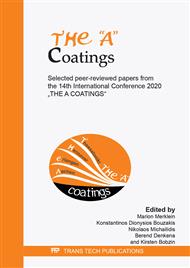p.28
p.39
p.45
p.53
p.61
p.68
p.77
p.85
p.95
Residual Stress Measurements in PVD Coatings of Carbide Cutting Tools Directly in the Cutting Edge
Abstract:
Residual stress measurements directly in the coated cutting edge are not possible with X-ray diffraction (XRD) due to the diameter of the X-ray beam. On the other hand, Raman microscopy enables measurements on the micrometer scale. Parameter variations in the PVD process were used to provide different residual stress states in (Al,Ti)N coatings on carbide cutting tools. They were examined by XRD in regions that can be reliably measured. The same area was then examined by Raman microscopy to determine the relationship of Raman peaks to the residual stress. Local high-resolution Raman measurements were then taken at the cutting edge and further influences on the Raman peak position besides residual stresses were excluded. In order to analyze the relationship between Raman peak shift and residual stress state, measurements were performed during a bending load. Finally, an outlook on further investigations is given.
Info:
Periodical:
Pages:
61-67
Citation:
Online since:
October 2020
Keywords:
Price:
Сopyright:
© 2020 Trans Tech Publications Ltd. All Rights Reserved
Share:
Citation:


